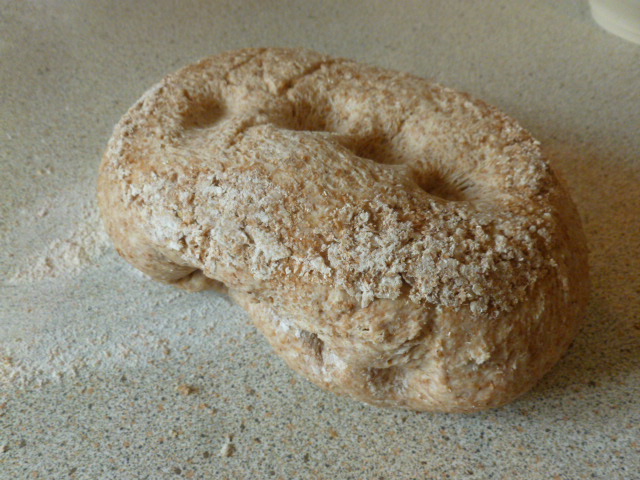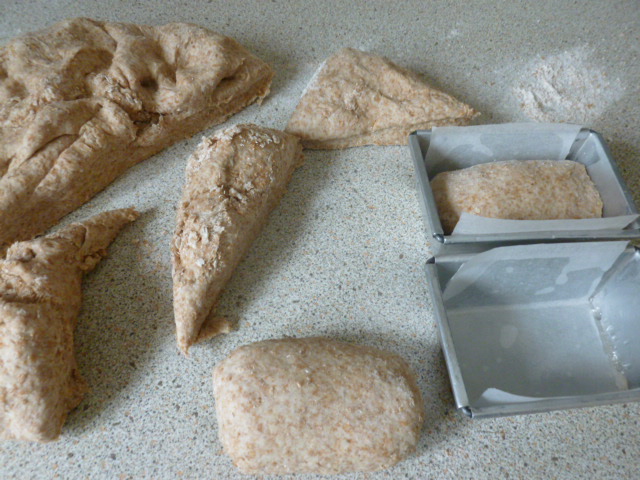One of the skills I was asked to teach more than anything in the four years of running our cookschool in France was breadmaking. Not fancypants bread, just a good loaf that our guests could make successfully at home with minimum fuss and maximum pleasure. Just going through the processes of mixing, kneading, proving and baking to show how easy it is the make a good loaf was something I never tired of. When we returned to England after our 10 year French adventure I vowed to make bread each week. I have to admit I haven’t stuck to this but I have gradually started to make bread regularly and with a huge sense of satisfaction. We can buy good bread here, notably from the Hobbs House bakery run by the Fabulous Baker boys, but at three quid a loaf it doesn’t come cheap. A big bag of Wessex Mill wholemeal flour costs £1.50 and is enough to make three large loaves, so it really is worth the effort. If you follow my recipe I promise you can’t go far wrong. You can shape the dough however you wish, make rolls or small loaves, or even use it as a pizza base. The little tins I used to make my little loaves were picked up from a flea market but you can buy similar cutely shaped tins from Lakeland.
So reach for a big bowl, follow my recipe and I promise you’ll be in for a treat. You can pick up fresh yeast from bakers or at the bread counter of most larger supermarkets.
Simple bread
Makes one large loaf or 10 rolls
500g strong bread flour. White, brown, granary, spelt, whatever
7g sachet easy blend dried yeast or 10g fresh yeast
2 tsp salt
1 tsp sugar
300-350ml hand hot water
2 tbsp olive oil or melted butter
1 Tip the flour into a large bowl. If you are using dried yeast stir this into the flour. If using fresh crumble this into the flour and rub it in with your fingertips. Stir in the salt and sugar.

2 To get the water to the right temperature mix one third hot from the kettle to two thirds cold. If you are using white flour 300ml should be enough. For granary or wholewheat flours use 350ml. Make a well in the centre of the flour and pour in the water and oil or butter all at once. It’s better to add too much water than not enough as a tight dough will not rise well and you’ll end up with a brick.
3 Mix quickly using a wooden fork or your hands until you have a soft dough. Knead the dough for 5 mins on a lightly floured surface until it feels silky and smooth and no longer sticky. When the dough is ready it will feel springy and elastic.

4 Drizzle a little oil into your mixing bowl(no need to wash), add the dough and turn it over to coat with the oil. Cover the bowl with a teatowel and leave to rise for 1 hour, after which time it will have doubled in size and the dough will spring back when you poke it. Heat the oven to 240C/220C fan/Gas 8.
5 Shaping the dough. Tip the dough out onto a lightly floured surface and knead briefly.
To make a loaf Generously oil a 1kg loaf tin. Press the dough to an oblong the length of the tin and three times the width. Fold it into three and drop into the tin. Leave to rise for 30 mins. Bake for 30-35 mins.
To make a cob Shape into a large ball, put on a floured baking sheet and leave to rise for 30 mins. Slash the top with a sharp knife and bake 30-35 mins
To make rolls divide the dough into 10 equal sized pieces(about 80g each) and shape into balls or drop into well oiled tins shaping as for the large loaf. Put the rolls on a floured baking sheet and leave to rise for 30 mins. Bake 15-20 mins.
When the bread is cooked it will feel hollow when tapped on the base. Cool on a wire rack and eat within 2 days or freeze for up to 1 month.